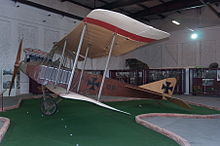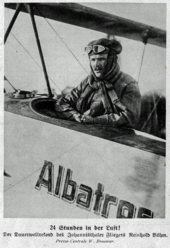Albatros BI
| Albatros BI | |
|---|---|
 Albatros BI version with three pairs of handles |
|
| Type: | Reconnaissance and training aircraft |
| Design country: | |
| Manufacturer: | |
| First flight: |
1913 |
| Commissioning: |
1913 |


The Albatros BI (also called Albatros military biplane in contemporary sources ) was a German military aircraft. It was designed as a reconnaissance aircraft and flown as such in the Air Force until 1915 , the internal factory designation was L-1. When the First World War broke out, a military designation system was introduced, and the model was now called Albatros BI. Phönix Flugzeugwerke built the aircraft under license for Austria-Hungary .
construction
With the well -engineered half-shell wooden fuselage constructions by chief engineer Hugo Grohmann , Albatros had low-weight and high-performance fuselage constructions. In 1913, Ernst Heinkel and Robert Thelen developed the Albatros DD ( double decker , later military name Albatros BI ) as the most important type on this wooden hull base . The landing gear consisted of a fixed two-wheeled main landing gear with a continuous axle and a tail spur. Braking was done with a hook attached to the chassis axis. There was also a floatable version, the Albatros WDD (W.1).
Versions
The machine was equipped with Mercedes engines of 75, 100 and 120 hp, which drove a fixed two-bladed wooden propeller. The wingspan varied. Depending on the span, there were versions with a pair of handles (Albatros racing double decker) as well as two and three pairs of handles.
use
In 1914, the BI was able to set a height record. From July 10th to 11th, 1914, the Albatros works pilot Reinhold Böhm set the world record for endurance flights with a flight duration of 24 hours and 10 minutes. The altitude and endurance flight records were set with the three-pair version.
Because of its inferiority to Allied fighters , the aircraft was withdrawn from active service at the front in 1915 and served as a training aircraft until 1918 .
Technical specifications
| Parameter | Data |
|---|---|
| crew | 2 |
| length | 8.55 m |
| span | 14.30 m |
| height | 3.50 m |
| Wing area | 43.00 m² |
| Empty mass | 600 kg |
| Payload | 200 kg |
| Max. Takeoff mass | 800 kg |
| Top speed | 100 km / h |
| Take-off run | 50 m |
| Climb performance | 1.00 m / s |
| Max. Range | 650 km |
| Engine | a water-cooled 6-cylinder in-line Mercedes engine, 100 HP (74 kW) starting power |
Web links
Individual evidence
- ↑ a b c d James F. Miller: DH 2 vs Albatros DI / D II - Western Front 1916 . Osprey Publishing (UK), Oxford 2012, ISBN 978-1-84908-704-9 .
- ↑ Aviation No. 15/1914 of July 22, 1914, p. 631ff
- ^ Johannisthal letter . From our Johannisthal correspondent. In: Carl Oskar Ursinus (Ed.): Flugsport . No. 15 . Verlag für Flugsport, Frankfurt am Main July 22, 1914, p. 631 ( Aviation in the Luftfahrt-bibliothek.de [accessed on August 19, 2018]). , Page 631ff

